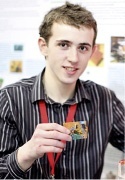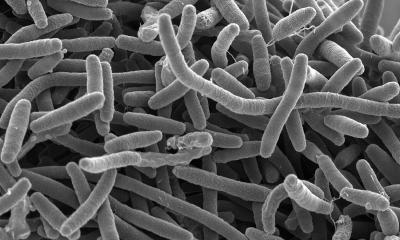Do-it-yourself scientific testing
Teenager builds DNA machine at home
A British teenager, 17-year-old Fred Turner, has won a major accolade for building a DNA testing analyser in his own home for a few hundred euros.

His achievement has been recognised by leading scientists and helped him win the prestigious Young Engineer of the Year Award in the UK. Fred explained that he built a PCR (Polymerase Chain Reaction) machine to amplify a target DNA sequence along with equipment for electrophoresis to set up a home genetics lab. A key component of his award-winning project was to identify the gene mutation that gives his brother Gus ginger hair.
To build the PCR machine as cheaply as possible the parts were ‘scavenged’ from the electronics of old computers and a video player, while the microcontroller is an Arduino Mega, which is an open source and cheap microcontroller. He bought electrical components only when absolutely necessary, designed all the electronics and carried out the programming required for the touch screen and precise heater control using only the limited tools he had available at his home in Brighouse, West Yorkshire.
Total prototype cost was about £400 (€475), though now he has the completed designs he believes he can build another model for as little as £250 (€300).Fred said he learned how to build the PCR machine from the internet and also by taking apart a broken PCR machine that a university laboratory had discarded.
The desire to build the machine was triggered by a long-standing ambition to be able to read his genetic code. ‘Investigating the genetic basis of my brother’s ginger hair was another project I carried out as a “proof of concept” that the machine and my lab worked and because it was a test that I found personally interesting,’ he said.
He conducted the analysis by extracting DNA from buccal cells from his brother’s cheek using an alkaline lysis technique with the DNA undergoing PCR in his machine to target the specific gene under investigation and increase the amount of DNA for the next stage of the process.
Fred added: ‘Depending on the gene I’m investigating, there are two different analysis steps that can be used next. If I am investigating either an insertion or a deletion in a certain gene, I can run the PCR product on an agarose gel using electrophoresis on equipment I built. This allows me to determine the length of the DNA fragment that was amplified by the PCR and thus determine if the insertion/deletion is present. I can carry out this technique at home.’
However, for some genes where he is looking for changes in a single base pair, often referred to as SNPs (Single Nucleotide Polymorphisms), he has to send the DNA to a lab that carries out the sequencing reaction, as he cannot do this at home due to the expense of reagents and equipment.
To read the results of his tests, he built a transilluminator that allows him to see the DNA in an agarose gel using a fluorescent dye and ‘read’ the results when looking at insertions/deletions and allows him to estimate the length of the DNA fragment produced in PCR.
‘When I get the results back from the sequencing lab I perform several different techniques on the computer to work out what the results mean,’ he said. ‘This usually involves doing a BLAST search (on the NCBI website) of the sequence, aligning the sequence to a reference sequence to look for mutations, or looking at the electrophoreogram to determine if there are any heterozygous SNPs.’
As for his analysis of the ginger gene, he found that his brother has a deletion of a single A at position 85 of the gene MC1R (Melanocortin 1 receptor) which causes a frame shift mutation, producing a non-functional receptor and leading to his ginger hair.
Fred’s Genetics at Home project – which won him the UK’s Young Engineer of the Year award in the National Science + Engineering Competition organised by the British Science Association - highlighted how anyone can carry out basic genetic tests for a fraction of the cost of existing technology. The panel of judges included Hadron Collider physicist and TV presenter Professor Brian Cox, renowned space scientist Dr Maggie Aderin-Pocock and Nobel Prize winning biochemist Sir Tim Hunt.
03.08.2013











